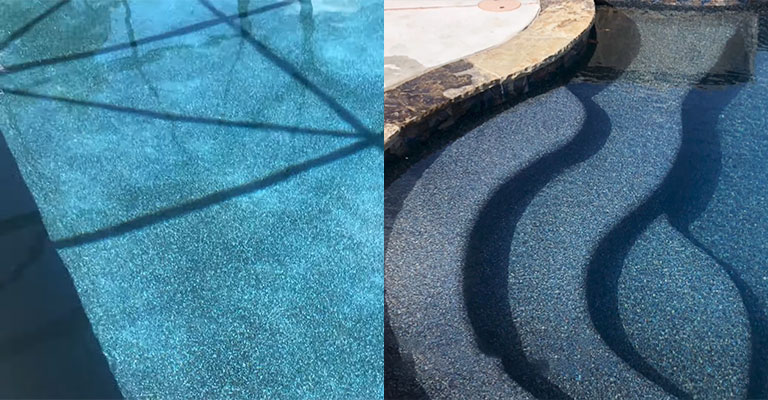With the advancement of technology, there are more and more choices for homeowners when it comes to choosing the perfect finish for their swimming pool.
The decision of what kind of pool finish to use is something that every homeowner should think about.
There are many options available, but it’s important to weigh the pros and cons of each one before making your final decision. For this article, we are going to look at the difference between quartz vs. pebble pool finish.
What Is The Difference Between Quartz And Pebble Plaster?
What are the differences between pebbles, specifically mini-pebble and quartz? These are two of the most common questions we are asked during consultations.
There is a significant difference in the aggregate stone size used in these surfaces. This quartz finish is made of crushed stone, whereas the pebble finish is made of tumbled stone.
It would be best if you made an informed decision when refinishing your swimming pool’s interior. We can help you do that. Both of the surfaces mentioned above are exposed aggregate.
About Pebble Pool Finish
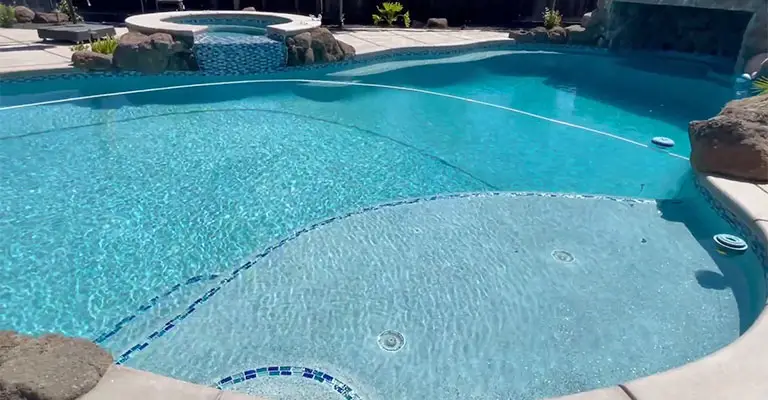
There is no better material to resurface pools than Mini Pebbles. This material is made up of specially formulated cement combined with a mixture of tumbled pebbles.
Pebbles are used as the majority of a spa or pool’s surface to simulate the natural beauty of creeks and riverbeds.
Suppose you plan to stay in your home for an extended period. In that case, you should seriously consider this product since it has a typical lifespan of 18-22 years and a manufacturer’s warranty for up to a lifetime on the material.
About Quartz Pool Finish
Marquis quartz is an exposed aggregate coating designed specifically for swimming pools consisting of polymer-modified cement, quartz aggregates, and various admixtures. This surface has exceptional slip resistance and is long-lasting.
There is a manufacturer’s warranty on the material of 10 years for this product with a typical lifespan of about 10-12 years. So, this is a surface that you can enjoy for many years, even if it does not have the longevity that a mini pebble surface may have.
Difference In Cost
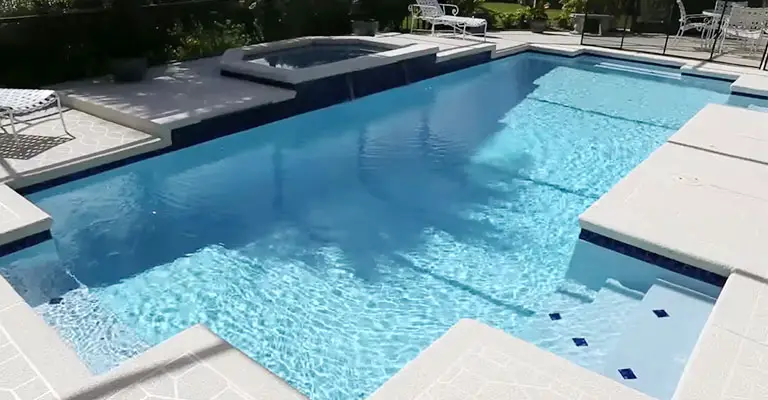
Homeowners and pool builders are drawn to quartz finishes. Despite all their benefits, quartz blends are more expensive upfront-roughly 20 to 30 percent more than plain marcite.
Despite this, they almost always provide superior long-term value since they are more durable — usually by 10 to 15 years — so they can last longer.
Pebble surfaces are more expensive than marcasite and quartz aggregates, but they are a luxury upgrade. Prices for pebble surfaces are roughly 45 to 60 percent higher than for marcite surfaces.
In fact, your finish costs will increase by at least two to three thousand dollars for a medium-sized, 20,000-gallon pool. It may even increase by several thousand dollars in some states.
Lifespan
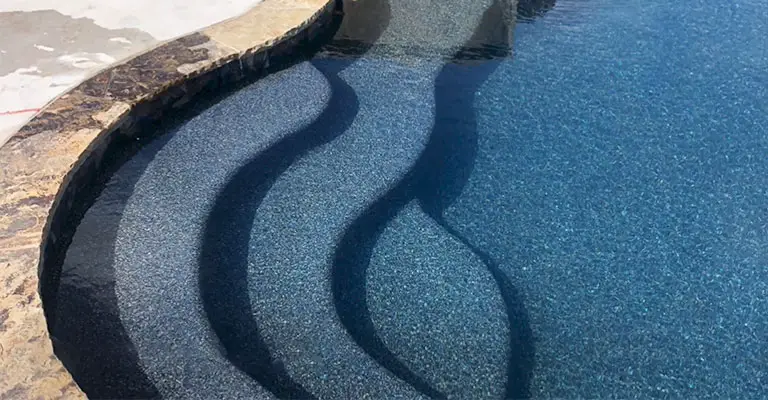
Typically, quartz surfaces offer a greater return than traditional plaster because their durability exceeds that of the former by 10 to 15 years, providing a long-term financial benefit.
On the other hand, Pebble finishes will likely look good for 12 to 14 years. The cost of maintaining a pebble finish may be lower in the long run.
Versatility & Looks
Pebble finishes come in a wide variety of colors, so you can create an aesthetic that is both eye-catching and functional. Pebbles can be used to portray the feeling of a lakebed, mountain stream, or tropical vacation spot.
The natural mineral not only provides increased durability and functionality but also delivers on the style front. On the other hand, the colors of quartz blends include blues, reds, whites, grays, tans, and teals.
With the finish applied, your pool will have a beautiful, speckled pattern, so you can enjoy gazing at it no matter how far away you are.
In addition, speckled patterns hide blemishes far better than plain plaster if mild stains or etchings eventually occur over time.
Durability
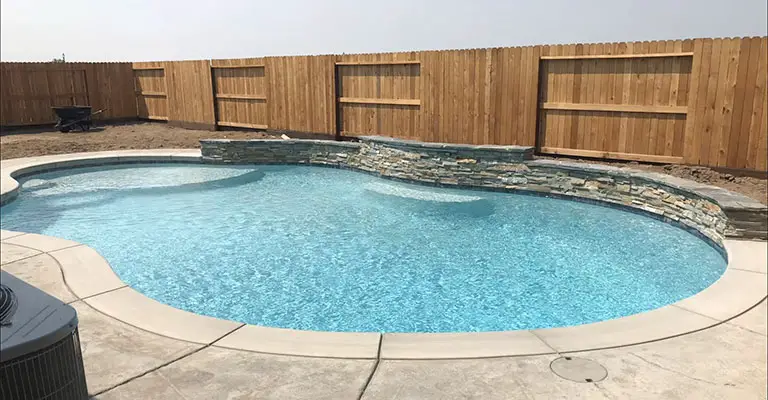
In general, quartz is considered to be a hard mineral. Therefore, it is more difficult to scratch and more resistant to chipping and etching than marcite.
Quartz is used as an interior finish for new and renovated pools to create a solid, stain-resistant surface. In addition, it performs better and lasts longer at combating erosion caused by chemical imbalances in the water.
Some manufacturers offer pebble finishes that are pre-bagged, factory mixed, and available in a variety of colors. The colors, therefore, are uniform, allowing for a near-perfect color match if a repair is ever needed.
The application process for marcite and quartz, however, is labor-intensive. For example, pebble-finish swimming pools usually require separate visits from the plaster crew on different days.
Texture
Similarly, the textures differ. Compared to quartz blends, some blends with large stones may be rougher.
Take comfort into consideration when selecting a blend. Some pebble blends may feel unpleasant to your naked skin, especially those with large sizes and textures.
If you sit on a pebble-covered ledge or step for a while, you may even get temporary pockmarks on your skin. This is because decorative ceramic pigments are permanently bonded to the surface of the quartz pieces for a beautiful, robust exterior.
It is applied to the interior of the shell of a swimming pool in a similar way to plain marcite plaster.
Although the application procedure is the same, the final outcome may differ. The interior of an inground swimming pool can be strengthened, made more beautiful, and more durable with quartz finishes.
Similarities Between The Two
There are some similarities between quartz and mini-pebble plaster pool finish, which includes:
- Installation of both requires highly skilled pool builders
- Natural minerals and white cement make up both
- It is possible to get a lifetime warranty on both
- Both are plaster finishes for the interior of a swimming pool
Which One Is Better?
You’ll have to decide what kind of interior finish to use when building a swimming pool or updating an existing one. Initial budget outlays for quartz aggregate, and pebble finishes will be higher.
As discussed here, the good news is that they offer greater color and style options, add visual appeal to a pool, and resist and hide a variety of blights. Above all, they will prevent you from having to replaster your pool for several years.
You can get years of extra pleasure from a new or renovated backyard resort with upgraded finishes if it fits your budget.
Final Words
In the end, it’s all about the applicator, no matter what surface you choose. A pebble will generally last longer than a quartz surface. However, both surfaces can be expected to last for decades with the right water chemistry management.
The floors could need refinishing within five years if the water is not managed properly due to scaling or etching. Remember that choosing the right finish is less important than how your system is installed, started up, and managed.

